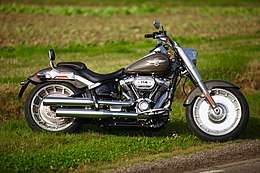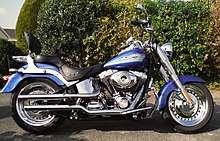Harley-Davidson Fat Boy
The Harley-Davidson Fat Boy, is a V-twin softail cruiser motorcycle with solid-cast disc wheels.[2]. Designed by Willie G. Davidson and Louie Netz, Harley-Davidson built a prototype Fat Boy in Milwaukee for the Daytona Bike Week rally at Daytona Beach in 1988 and 1989.[3][4] Fat Boys produced from 1990-2017 are coded FLSTF, and FLFB (& FLFBS) from 2018.
 | |
| Manufacturer | Harley-Davidson |
|---|---|
| Production | Since 1990 |
| Class | Cruiser |
| Engine |
1,868 cc (114 cu in) |
| Transmission | Chain (Primary) / Belt (final drive) |
| Brakes | Disc/disc |
| Wheelbase | 1,636 mm (64.4 in) |

The name is said to come from the bike's "massive presence", and that the name gave a link to the earlier Harley-Davidson "Fat Bob" model.[5][6]
History and development
The Fat Boy's frame is derived from the 1984 "Softail" which appears to have a rigid hardtail chassis but which in fact has a swinging arm with concealed springs that was originally designed in a Missouri garage in the 1970's by "a mechanical engineer" named Bill Davis and later Patented in 1976.[7] Willie G the grandson of Harley-Davidson co-founder William A. Davidson originally turned down engineer Bill Davis' softail concept; but the company later relented, buying the rights and designing its own softail frame in-house.[8]
- After 1994, the exhaust was made seamless.
- In 1996 the master cylinder and switch gear were revised.
- In 1999 a new 1,450 cc (88 cu in) Twin Cam engine for the 2000 model year was used. This necessitated a bespoke engine variant and changes to the frame.
- In 2002 bullet-style indicators, alarm and immobilizer were added.[9]
- In 2005 a 15th Anniversary version was sold, with a "Screamin' Eagle" engine, special paint and custom wheels.[9]
- In 2007 the displacement was increased to 1,584 cc (96.7 cu in)[9] and the transmission changed six speeds.[8]
- The 2010 "Fat Boy Lo" FLSTFB had the lowest ever Harley seat height.[2]
- In 2012 the Fat Boy received the new 1,690 cc (103 cu in) Twin Cam engine along with the rest of the softail range*
The 2018 Fat Boys have a redesigned softail frame with Showa front and rear suspension and new twin-counterbalanced Milwaukee-Eight engines. The two 2018 variants comprise:
- The FLFB 1,746 cc (107 cu in) with 109 lb⋅ft (148 N⋅m), and
- The FLFBS 1,868 cc (114 cu in) with 119 lb⋅ft (161 N⋅m)[10]
The 2018 Softail frame has a modified swingarm with a Showa rear monoshock suspension mounted beneath the seat (replacing earlier twin shocks). So as to provide a more comfortable and better controlled ride with improved handling, the front forks contain a Showa "Dual Bending Valve" (SDBV),[11] a cartridge simulator using two valves to control compression and rebound damping, giving linear damping characteristics proportional to fork stroke speed. Harley-Davidson claims the 2018 chassis is stiffer and lighter than earlier Softail and Dyna platforms.[12] Further upgrades include an LED headlight and 18-inch “Lakester” rims, with wider 160mm front and 240mm rear rubber.[13][14]
For 2020, the Fat Boy is only available with the Milwaukee-Eight 114 engine. Harley-Davidson also produced a 30th Anniversary edition for 2020. [15]
It is one of Harley-Davidson's best selling models, and has appeared prominently in a number of TV shows and movies.[3] The Fat Boy earned a place in American pop culture after appearances in the movie Terminator 2: Judgment Day. One of the motorcycles used in Terminator 2 is displayed at the Harley-Davidson Museum. It appeared again in Terminator Genisys.[2][16][17][18]
References
- "MOTO USA". Retrieved 25 October 2016.
- "Harley Fat Boy History". Harley-Davidson. Retrieved 25 October 2016.
- "Fat Boy a Harley bestseller and Hollywood favorite for 25 years". Milwaukee Wisconsin Journal Sentinel. Retrieved 28 October 2016.
- "Vehicle Profile:25 Years of the Harley-Davidson Fat Boy". Harley-Davidson. Archived from the original on September 20, 2017. Retrieved May 28, 2017.
- origins of the name Fat Boy [https://itstillruns.com/harley-called-fat-boy-5167584.html}%5B%5D
- Fat Boy history
- Masker, Mark. "Three decades of Softail". Hot Bike. Bonnier Corporation. Retrieved May 21, 2019.
- "Harley Fat Boy Launch". Sump Magazine. Retrieved 25 October 2016.
- "Harley Fat Boy Development". Hogrides. Retrieved 25 October 2016.
- Cameron, Kevin (August 22, 2017). "2018 Harley-Davidson Softail Cruisers Tech and Development". Cycle World. Retrieved September 17, 2017.
- SDBV image
- "2018 Harley-Davidson Softail Cruiser Lineup". Cycle World. 2017. Retrieved September 9, 2017.
- MacDonald, Sean (August 22, 2017). "This Is The New 2018 Harley-Davidson Softail Fat Boy". Cycle World. Retrieved July 9, 2018.
- MacDonald, Sean (August 22, 2017). "This Is The New 2018 Harley-Davidson Softail Fat Boy". Cycle World. Retrieved July 9, 2018.
- "2020 Harley-Davidson Fat Boy 30th Anniversary Unveiled". UltimateMotorcycling.com. Ultimate Motorcycling. Retrieved 18 February 2020.
- "'Terminator' Fat Boy preserved". Motorbike Writer. Retrieved 26 October 2016.
- Barrett, Rick (July 22, 2015). "Fat Boy a Harley bestseller and Hollywood favorite for 25 years". The Milwaukee Journal Sentinel. Retrieved July 9, 2018.
- Hinton, TJ (January 12, 2018). "Low Seat Height, Butt-Friendly Saddle, And A Smooth Ride". Top Speed. Retrieved July 9, 2018.